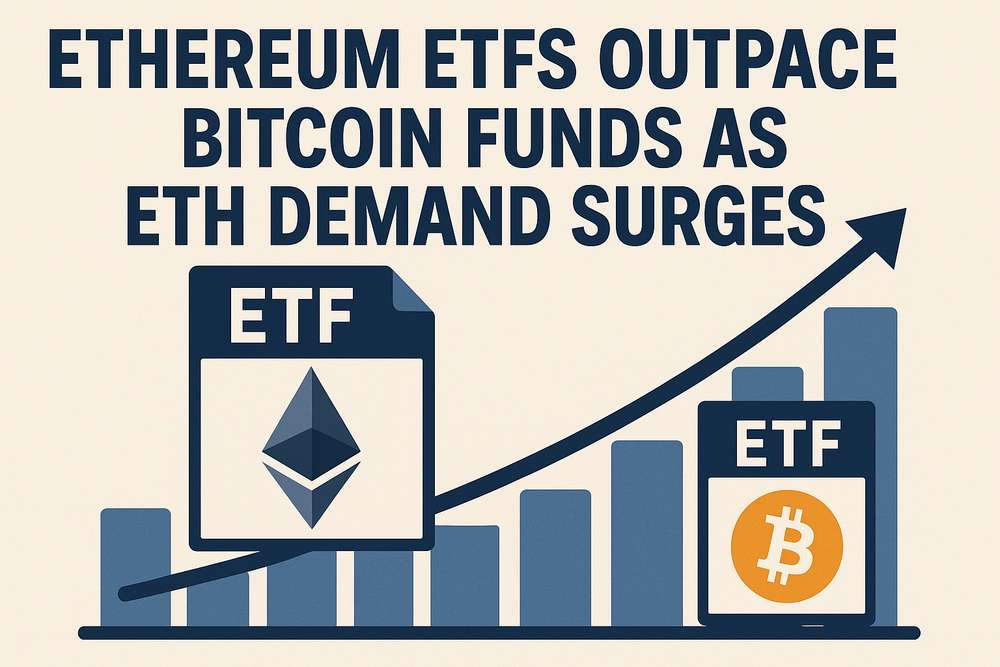Ethereum ETFs have surged forward of Bitcoin counterparts, capturing $2.4 billion in internet inflows over six buying and selling days in comparison with Bitcoin’s $827 million, marking a pivotal shift in institutional crypto funding methods. BlackRock’s iShares Ethereum ETF (ETHA) dominated with $1.79 billion, whereas Constancy’s Ethereum Fund (FETH) hit a single-day report of $210 million on July 24, 2025. This momentum contrasts with Bitcoin ETF outflows, which noticed a $131 million reversal after a 12-day influx streak. Analysts attribute Ethereum’s rise to its post-merge effectivity, DeFi integration, and Layer-2 scalability, positioning it as a utility-driven asset past Bitcoin’s store-of-value narrative.
Ethereum ETFs Seize Institutional Consideration
Ethereum’s ETF inflows reached $4.4 billion in July 2025 alone, surpassing Bitcoin’s cumulative inflows for the yr. The surge aligns with Ethereum’s 18% value soar over the previous week, pushed by optimism round stablecoin laws and technological developments. Spot ETH ETFs attracted $231.23 million on July 24, narrowly edging Bitcoin’s $226.61 million, a primary in ETF historical past. This development displays rising confidence in Ethereum’s ecosystem, together with decentralized purposes and good contract platforms.
Bitcoin ETFs Face Outflows Amid Shift
Bitcoin ETFs, as soon as the dominant crypto funding car, confronted a $131 million internet outflow on July 28, ending a 12-day influx streak that had collected $6.6 billion. Whereas Bitcoin stays a benchmark for crypto volatility, its current efficiency highlights a rotation towards Ethereum’s innovation-driven narrative. Bitcoin’s position as “digital gold” contrasts with Ethereum’s utility in decentralized finance (DeFi) and blockchain infrastructure, influencing institutional allocation selections.
BlackRock and Constancy Lead the Cost
BlackRock’s ETHA ETF captured 75% of Ethereum’s whole inflows, underscoring its dominance in institutional crypto markets. Constancy’s FETH, in the meantime, achieved a single-day report of $210 million, signaling robust demand from skilled buyers. These funds profit from Ethereum’s post-merge effectivity positive factors, which lowered vitality consumption by 99.95% and improved transaction throughput.
Market dynamics between Ethereum and Bitcoin ETFs reveal diverging investor methods. Bitcoin ETFs enchantment to long-term holders looking for stability, whereas Ethereum attracts these betting on technological adoption and DeFi development. This bifurcation is clear in volatility patterns: Bitcoin’s value swings usually correlate with macroeconomic components, whereas Ethereum’s actions tie carefully to blockchain innovation.
Regulatory developments additional amplify Ethereum’s enchantment. Proposed stablecoin laws within the U.S. has boosted confidence in Ethereum’s ecosystem, as stablecoins rely closely on its community for transactions and DeFi protocols. This regulatory tailwind, mixed with Ethereum’s technological edge, positions it as a primary beneficiary of institutional crypto adoption.
Efficiency comparisons spotlight Ethereum’s current dominance:
| Class | Ethereum ETFs | Bitcoin ETFs |
|---|---|---|
| 6-Day Inflows | $2.4B | $827M |
| Single-Day Report | $210M (FETH) | N/A |
| 2025 Inflows | $4.4B+ | $6.6B (12-day streak) |
These figures underscore Ethereum’s rising institutional footprint, with ETFs now representing 5% of its market cap. Analysts word that Ethereum’s ecosystem—spanning DeFi, NFTs, and Layer-2 options—affords diversification past Bitcoin’s store-of-value thesis.
Trying forward, Ethereum’s ETF momentum could persist as Layer-2 scaling options like Arbitrum and Optimism improve community effectivity. Nonetheless, Bitcoin stays a crucial hedge towards market volatility, notably throughout macroeconomic uncertainty. The divergence in ETF flows displays broader institutional methods: Ethereum for development and innovation, Bitcoin for stability and danger mitigation.
Set up Coin Push cell app to get worthwhile crypto alerts. Coin Push sends well timed notifications – so that you don’t miss any main market actions.
Market Impression: Ethereum’s ETF dominance alerts a maturation of institutional crypto methods, prioritizing utility over hypothesis. This shift might speed up adoption of DeFi and blockchain infrastructure, whereas Bitcoin’s position as a reserve asset stays intact. The bifurcation could result in a extra diversified crypto market, with ETFs serving as gateways for various danger profiles.
- ETF
- An exchange-traded fund that tracks the value of an asset, permitting buyers to achieve publicity with out direct possession. Crypto ETFs allow regulated entry to Bitcoin or Ethereum.
- DeFi
- Decentralized finance refers to blockchain-based monetary providers, comparable to lending and buying and selling, that function with out conventional intermediaries.
- Layer-2
- Scalability options constructed on prime of Ethereum’s most important blockchain, enhancing transaction pace and decreasing charges whereas sustaining safety.
- Good Contracts
- Self-executing agreements with predefined guidelines, routinely enforced on blockchain networks like Ethereum.
- Stablecoins
- Cryptocurrencies pegged to fiat currencies (e.g., USDT, USDC), used for secure worth transfers and DeFi purposes.
This text is for informational functions solely and doesn’t represent monetary recommendation. Please conduct your personal analysis earlier than making any funding selections.
Be at liberty to “borrow” this text — simply don’t neglect to hyperlink again to the unique.

Editor-in-Chief / Coin Push Dean is a crypto fanatic based mostly in Amsterdam, the place he follows each twist and switch on this planet of cryptocurrencies and Web3.
